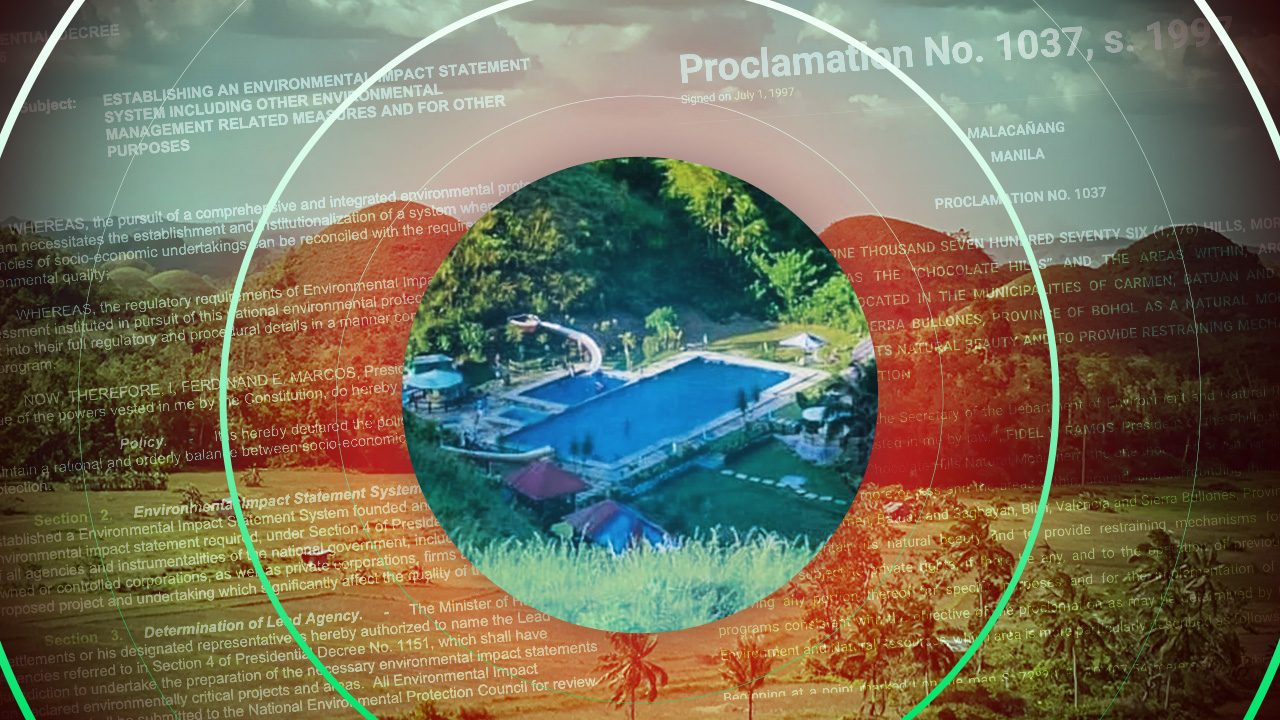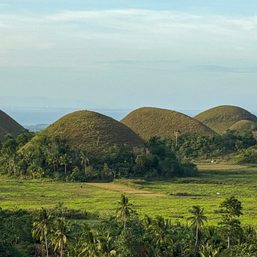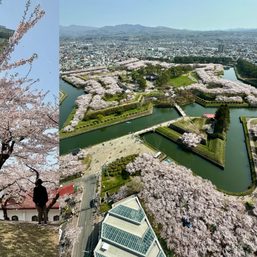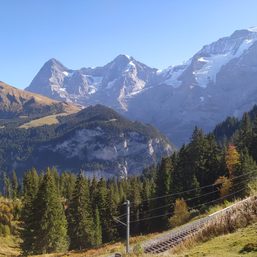SUMMARY
This is AI generated summarization, which may have errors. For context, always refer to the full article.

CEBU, Philippines – The controversy over Captain’s Peak Resort – an establishment built within the protected area of the Chocolate Hills – sparked multiple debates about accountability in the preservation of the nation’s protected areas. This accountability covers government agencies and private tourism site owners of Bohol and the whole Visayas region.
For starters, it was former president Fidel V. Ramos, through Proclamation No. 1037, s. 1997, who declared a “natural monument” around 1,776 chocolate hills and the areas within, around, and surrounding them.
These hills, identified in the towns of Carmen, Batuan, Sagbayan, Bilar, Valencia, and Sierra Bullones in Bohol, are to be protected and placed under the jurisdiction of the Department of Environment and Natural Resources (DENR), in coordination with national agencies and local government units.
Former president Gloria Macapagal-Arroyo amended Ramos’ proclamation via Proclamation No. 333 on February 26, 2003, excluding the “alienable and disposable flat lands” found near the hills but still maintaining the “buffer zones” found 20 meters from the base of each hill.
In the case of Captain’s Peak Resort in Sagbayan town, structures were built at the foot of three chocolate hills. Rappler visited the resort and saw that a pool was placed at the center of the hills.
As netizens, concerned citizens, and lawmakers got riled up in discussions about the violations committed by the resort owners, the debate eventually revolved around the issuance of a business permit and lack of certain requirements like the Environmental Compliance Certificate (ECC).
Julieta Sablas, the administrator of Captain’s Peak Resort, told Rappler on Thursday, March 14, that they were given a business permit by the Office of the Mayor of Sagbayan even without an ECC.
But what exactly is an ECC and why is it so important for any business operating near protected areas to have one?
Permit to operate
Under Presidential Decree No. 1586, signed by former president Ferdinand E. Marcos on June 11, 1978, no person, partnership, or corporation is allowed to undertake or operate a declared environmentally critical project (ECP) or area without first securing an ECC.
Based on the Environmental Management Bureau’s (EMB) Memorandum Circular No. 2014-005, applicants looking to secure an ECC must comply with the requirements set forth by the Philippine Environmental Impact Statement (EIS) System declared in Presidential Decree No. 1586.
These requirements include an Environmental Impact Assessment (EIA) report in the form of an EIS, Initial Environmental Examination (IEE) checklist report, Environmental Performance Report and Management Plan (EPRMP), and Programmatic EIS or Programmatic EPRMP.
The EIA is a process that evaluates the impact of the project on the environment where it will operate. Project proponents conduct the EIA with a consultant, EMB representatives, a review committee, and affected communities and stakeholders.
“It also includes designing appropriate preventive, mitigating and enhancement measures addressing these consequences to protect the environment and the community’s welfare,” the memorandum read.
The EIS is then formulated from the EIA study, following the Philippine EIS System guidelines and categorization of the projects that are ECPs.
As a natural monument, the Chocolate Hills fall under the first category of an environmentally critical area (ECA), which includes protected areas declared under the National Integrated Protected Areas System Act of 1992.
Category B for ECPs include projects that are not declared as ECPs by past presidential proclamations but are deemed to significantly affect the quality of the environment of ECAs.
“Proponents of these projects implemented from 1982 onwards are required to secure an ECC,” the memorandum read.
New ECC applicants for ECPs can send their EIS to the EMB Central Office at the DENR compound in Quezon City. Processing can take up to 20 working days depending on whether or not the EIS matches EMB standards.
Based on the EMB Ilocos Region official website, these are the processing fees for the following requirements:
- Programmatic EIS – P15,000
- EIS – P10,000
- Programmatic EPRMP – P10,000
- EPRMP – P10,000
- IEE Checklist – P5,000
- Documentary Stamp – P15
The EMB also has an online processing system that includes a longer list of 18 documentary requirements and an application fee of P5,055.
Building on protected areas
Besides an ECC, environmental lawyer Benjamin Cabrido Jr. told Rappler on Tuesday, April 2, that project proponents who want to operate in protected areas must acquire a Special Use Agreement in Protected Areas (SAPA).
Under DENR Administrative Order No. 2007-17, one of the primary objectives of the SAPA is to provide access and economic opportunities to indigenous peoples, tenured migrant communities and other stakeholders to contribute in “the reduction of poverty incidence.”
The lawyer said that protected areas are given different classifications which each have their own designated limitations for human activity.
These categories of protected areas, under the NIPAS Act, include strict nature reserves, natural parks, natural monuments, wildlife sanctuaries, protected landscapes and seascapes, resource reserves, and natural biotic areas to name a few.
“This strict nature of protection applies in cases of areas where there is a predominance of wildlife. In those cases, no one is allowed there,” Cabrido said in a mix of English and Cebuano.
However, for those considered as tenured migrants or those with properties in protected areas, the environmental lawyer explained that the national government respects the tenured migrant’s ownership of the land but limits usage of the property.
The administrative order defines the SAPA as a binding instrument between the DENR through the Protected Areas Management Board (PAMB) and SAPA applicants.
One of the special uses allowed within the protected areas, subject to the issuance of an ECC and approval of the DENR secretary or his or her authorized representative, is “Ecotourism Facilities.”
The first PAMB Resolution endorsing Captain’s Peak Resort described the proposed establishment as an “Eco-Park Tourism” facility.
Problematic issuances
The matter of ECCs has long been riddled with questionable documentary issuances and opposition by both government officials and environmentalists.
Cabrido criticized the way ECCs are issued because, according to him, it is usually only DENR representatives who conduct the assessments and are paid to do so.
“ECC is not a permit. Let us remember that. It doesn’t mean that when you are issued an ECC, you already have a permit to construct whatever you want inside your lot…it should have been named environmental conditional certificate,” the lawyer told Rappler.
Philippine Earth Justice Center (PEJC) managing trustee and environmental lawyer John Menguito told Rappler on Tuesday, March 26, that there have been multiple cases of projects that have been issued an ECC that are allegedly not compliant with environmental standards.
“What we usually do is challenge the issuance of the ECC via (studies) of third-party scientists…if it is compliant with legal standards, we look at science,” Menguito said.
The environmental lawyer said that the assessments for the ECC should also include environmental scientists and biologists, besides the mandated representatives and stakeholders.
On September 18, 2020, environmental experts in Cebu reported that marine life and corals were affected by mining operations in Alcoy town. These operations supplied dolomite sand to the controversial Manila Bay white sand project.
In a Rappler article dated September 25, 2020, Cebu Governor Gwen Garcia said that the mining operations had “obvious violations [of] the ECC.”
Through the years, green advocacy groups called for the revocation of multiple ECCs of all reclamation projects in Manila Bay, claiming that the projects had adverse effects on natural resources.
In June 2023, the DENR began its “cumulative impact assessment” on these development projects, a majority of which were later suspended by President Ferdinand Marcos Jr. on August 7, 2023.
As of Tuesday, April 2, DENR Secretary Toni Yulo-Loyzaga announced that the agency had suspended the power of regional offices to approve ECC applications.
“All pending and future ECC applications for projects within protected areas processed at regional offices shall be submitted to the EMB Central Office for final review and approval,” the DENR secretary’s memorandum dated Tuesday, March 26 read. – Rappler.com
1 comment
How does this make you feel?


















![[OPINION] Grading Marcos admin’s performance on the climate agenda](https://www.rappler.com/tachyon/2024/06/grading-marcos-performance-climate-agenda-june-25-2025.jpg?resize=257%2C257&crop=441px%2C0px%2C1080px%2C1080px)



![[Ilonggo Notes] Guimaras: Geared up for success](https://www.rappler.com/tachyon/2024/05/Ilonggo-Notes-Guimaras-May-6-2024.jpg?resize=257%2C257&crop=298px%2C0px%2C720px%2C720px)

Agree: “All pending and future ECC applications for projects within protected areas processed at regional offices shall be submitted to the EMB Central Office for final review and approval,” the DENR secretary’s memorandum dated Tuesday, March 26 read. So, were related applications not reviewed by the EMB Central Office in the past? Is this the cause of these abuses? Will this add another layer for those considering bribing DENR officials?